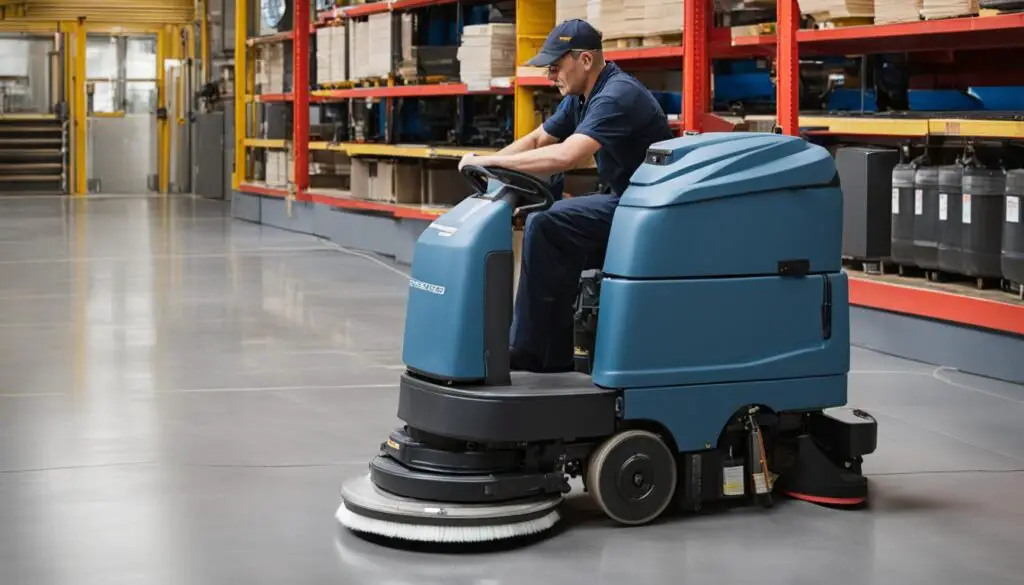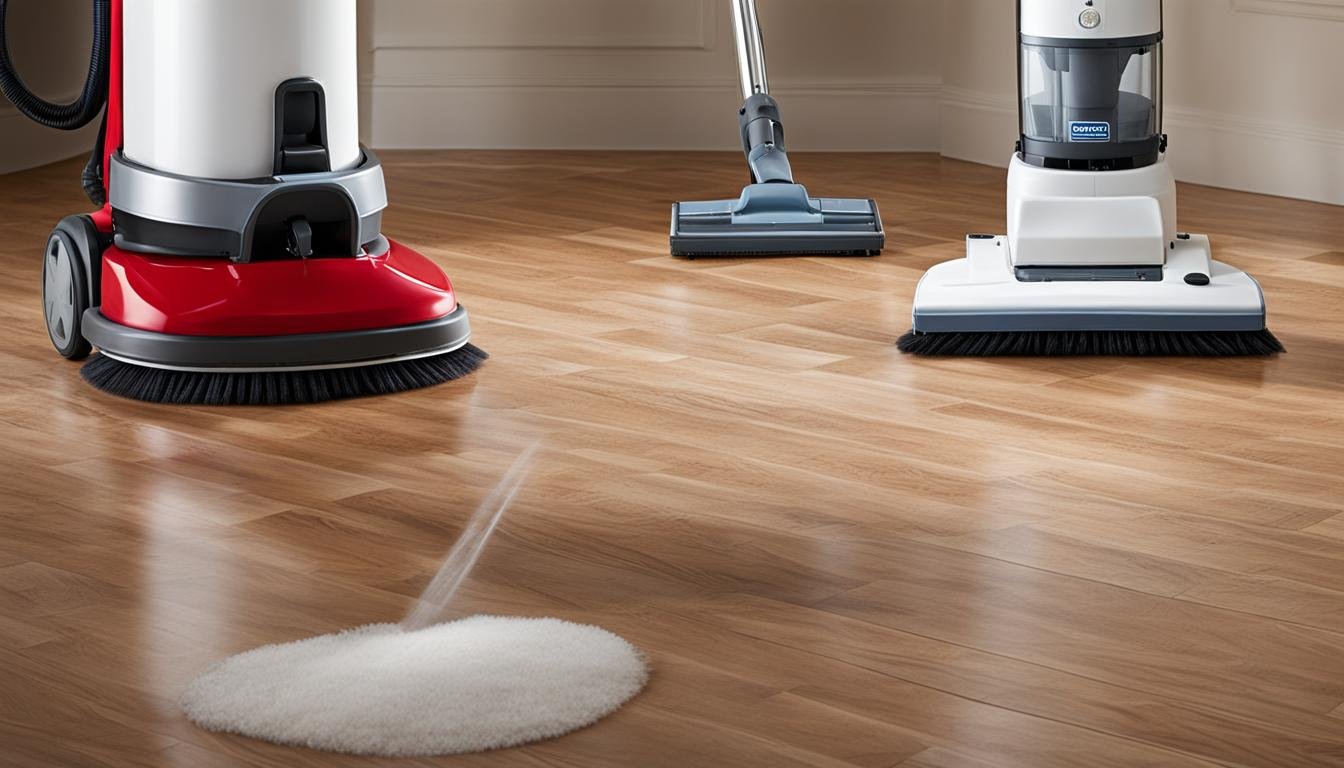Proper maintenance is crucial for ensuring the longevity and optimal performance of your floor buffer and vacuum cleaner. By following these maintenance tips, you can keep your cleaning equipment in top condition and maximize their effectiveness.
When it comes to your floor buffer, there are several important steps to keep in mind. After each use, make sure to wipe down the machine and spray lubricant on the handle adjustment assembly. Store pad holders individually and replace damaged plugs. Additionally, rinse dirty water tanks and valves, grease fittings if needed, and maintain batteries for autoscrubbers. For burnishers, regularly check cords and plugs for damage, blow out motor compartments, and examine and replace dust control shrouds as necessary.
For your vacuum cleaner, regular maintenance is equally important. Remember to empty the canister and clean the filters regularly. Replace vacuum bags frequently and remove debris from the brush compartment. Checking and replacing equipment filters, brush rollers, pads, and strips are essential steps to maintain optimal performance. If you own a wet/dry vacuum, be cautious not to vacuum up liquids, as it can cause damage. Additionally, inspect the beater bar for lint and debris and replace belts when necessary. Always refer to the manufacturer’s guidelines and consult the owner’s manual for specific maintenance tips.
By implementing these maintenance practices, you can extend the lifespan of your floor buffer and vacuum cleaner, ensuring they operate at their best. Now let’s explore some key takeaways:
Key Takeaways:
- Regularly wipe down and lubricate your floor buffer to maintain its performance.
- Store pad holders individually and replace damaged plugs.
- Rinse dirty water tanks and valves, grease fittings, and maintain batteries for autoscrubbers.
- Check cords, plugs, and dust control shrouds for damage in burnishers.
- Regularly empty the canister, clean filters, and replace vacuum bags for optimal vacuum cleaner performance.
- Remove debris from the brush compartment and inspect filters, brush rollers, pads, and strips.
- Avoid vacuuming up liquids with wet/dry vacuums to prevent damage.
- Check the beater bar for lint and debris and replace belts when necessary.
- Consult the owner’s manual for specific maintenance tips.
Tips for Maintaining a Floor Buffer
Proper maintenance is key to maximizing the performance and lifespan of your floor buffer. By following these routine maintenance steps, you can ensure that your floor buffer operates efficiently and effectively:
-
Wipe down and lubricate: After each use of a floor buffer, it is important to wipe it down to remove any dirt or debris. Additionally, spraying lubricant on the handle adjustment assembly helps to keep it functioning smoothly.
-
Remove and store pad holders: After use, remove the pad holders from the floor buffer and store them individually. This prevents any buildup of moisture or dirt that could potentially damage the pad holders or the machine itself.
-
Replace damaged plugs: Regularly inspect the plugs on your floor buffer and replace any that are damaged or worn out. This ensures a safe and secure electrical connection.
-
Rinse dirty water tanks and valves: Cleaning the dirty water tanks and valves helps to prevent the buildup of residue and prolongs the lifespan of your floor buffer. Regularly rinse these components after each use.
-
Grease fittings if needed: Some floor buffers have grease fittings that require lubrication. Check the manufacturer’s instructions and apply grease as necessary to ensure smooth operation.
-
Maintain batteries: If your floor buffer is battery-powered, it is important to regularly check and maintain the batteries. Follow the manufacturer’s guidelines for proper battery care and maintenance.
Floor Buffer Troubleshooting
If you encounter any issues with your floor buffer, here are a few troubleshooting tips:
Issue: The floor buffer is not starting.
Possible solution: Check the power source and ensure that the machine is properly plugged in. If it still does not start, check the fuse or circuit breaker.
Issue: The floor buffer is leaving streaks on the floor.
Possible solution: Check the condition of the pads or brushes. If they are worn out or damaged, replace them. Also, make sure that the floor surface is clean and free of debris before using the buffer.
Remember, regular cleaning and maintaining your floor buffer will not only extend its lifespan but also ensure that it performs at its best. Incorporate these maintenance tips into your routine to keep your floors looking their finest.

| Maintenance Steps | Tips |
|---|---|
| Wipe down and lubricate | After each use, clean the floor buffer and spray lubricant on the handle adjustment assembly. |
| Remove and store pad holders | Take out the pad holders and store them individually to prevent damage. |
| Replace damaged plugs | Regularly inspect plugs and replace any that are damaged or worn out. |
| Rinse dirty water tanks and valves | Keep the dirty water tanks and valves clean by rinsing them regularly. |
| Grease fittings if needed | Apply grease to fittings if necessary for smooth operation. |
| Maintain batteries | If your floor buffer has batteries, follow proper maintenance procedures to ensure their longevity. |
Tips for Maintaining a Vacuum Cleaner
Proper maintenance is vital to keep your vacuum cleaner running efficiently and prolong its lifespan. By following these simple steps, you can ensure that your vacuum cleaner stays in optimal condition for effective cleaning.
To start, make it a habit to regularly empty the canister and clean the filters. Clogged filters can hinder suction power and reduce cleaning performance. Replace vacuum bags frequently to prevent them from becoming too full, which can also impact the suction. Additionally, remember to clean out any debris from the brush compartment to keep the brush rollers working effectively.
Don’t forget to check the equipment filters, brush rollers, pads, and strips on a regular basis. Over time, these parts can wear down or become clogged with dirt, which can affect performance. Replace them as necessary to maintain the optimal function of your vacuum cleaner.
If you own a wet/dry vacuum, it is crucial to avoid vacuuming up liquids to prevent damage. Liquids can damage the motor and other internal components. Before using the vacuum, thoroughly read and follow the manufacturer’s guidelines and consult the owner’s manual for any specific maintenance tips for your vacuum cleaner model.
FAQ
How often should I perform maintenance on my floor buffer and vacuum cleaner?
It is important to perform routine maintenance on your floor buffer and vacuum cleaner after each use to ensure optimal performance and longevity.
What steps should I follow to maintain my floor buffer?
To maintain your floor buffer, wipe it down and spray lubricant on the handle adjustment assembly after each use. Remove and store pad holders individually, replace damaged plugs, rinse dirty water tanks and valves, grease fittings if necessary, and maintain batteries.
How can I troubleshoot issues with my floor buffer?
If you encounter issues with your floor buffer, examine cords and plugs for damage, regularly blow out motor compartments, and inspect and replace dust control shrouds as needed. Following the manufacturer’s guidelines and consulting the owner’s manual can provide additional troubleshooting tips for your specific floor buffer model.
What maintenance steps should I take for my vacuum cleaner?
Regular maintenance for vacuum cleaners includes emptying the canister, cleaning the filters, and replacing vacuum bags often. Additionally, remove debris from the brush compartment, check equipment filters, brush rollers, pads, and strips regularly, and follow the manufacturer’s guidelines and owner’s manual for specific maintenance requirements.
How can I maintain the batteries in my autoscrubber?
To maintain the batteries in your autoscrubber, regularly rinse dirty water tanks and valves, grease fittings if necessary, and follow the manufacturer’s guidelines for battery maintenance. Consulting the owner’s manual for specific autoscrubber batteries can provide additional tips.
What maintenance steps should I take for my wet/dry vacuum?
For wet/dry vacuums, it is crucial to avoid vacuuming up liquids to prevent damage. Regularly check the beater bar for lint and debris and change belts when necessary. Consulting the specific wet/dry vacuum owner’s manual can provide additional maintenance tips.





Leave a Reply